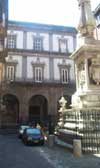|
|
|
 3rd
STAGE 3rd
STAGE
From via Duomo to Castelcapuano
Across
via Duomo, the main route picks up in the direction of Castelcapuano.
The first prominent landmark to come into view is the spire of San
Gennaro, which dominates the small square of Riario Sforza. It is
one in a series of such structures erected in the city as votive
monuments in times of calamity. It was designed by Fanzago and is
across from the Pio Monte della Misericordia complex, erected in
the 17th century by Francesco Antonio Picchiatti. The seven-arched
stone portico is marked by Ionian pilasters with draped--so-called
michelangiolina--festoons. From the portico there is an entrance
to the church, courtyard and hospice by way of a lovely stairway
restored by Mari Goffredo. The site is especially noted for its
art gallery, which contains, among many other works, some by Francesco
De Mura and--at the main altar--Caravaggio's Madonna of Mercy,
showing the Seven Works of Mercy.
| |
 After the square of Sedil Capuano, still on the same side, stands
the Santa Maria della Pace complex: the church with adjacent convent
and hospital, built partially on the site of the earlier Ser Gianni
Caracciolo palace, named for that powerful aristocratic favourite
of queen Giovanna II of Durazzo. The marble Gothic portal with circular
arches, columns and capitals with various designs, the base and
entrance passageway are all the oldest parts of this 14th- century
edifice that grew up around the original square courtyard closed
by a portico. Lush and green from the many shrubs and the vines
hanging from a lateral terrace, the courtyard is dominated by a
round clock with majolic quadrants flanked by small columns joined
by a broken triangular tympanum. From here, there is a covered passageway
to the upper gallery of the second courtyard with its ornamental
stone balustrade and which is set amid trees and flower gardens
lower than the first courtyard. Immediately thereafter is the last
building on via dei Tribunali, the Ricca palace from the 1500s and,
since 1819, seat of the Bank of Naples, which currently houses its
Historical Archives in the building. Behind the 18th-century facade
by Gaetano Barba, rebuilt between 1739 and 1773, the building retains
from its origins only the stone arches of the main stairway, which
opens on the left past the entrance passageway. At the back of the
courtyard, on the facade crowned by the clock of Gaetano Buoncore
(1740), is the entrance to the chapel, the Sacro Monte oratory,
built in 1663 to a design by Giuseppe Caracciolo.
After the square of Sedil Capuano, still on the same side, stands
the Santa Maria della Pace complex: the church with adjacent convent
and hospital, built partially on the site of the earlier Ser Gianni
Caracciolo palace, named for that powerful aristocratic favourite
of queen Giovanna II of Durazzo. The marble Gothic portal with circular
arches, columns and capitals with various designs, the base and
entrance passageway are all the oldest parts of this 14th- century
edifice that grew up around the original square courtyard closed
by a portico. Lush and green from the many shrubs and the vines
hanging from a lateral terrace, the courtyard is dominated by a
round clock with majolic quadrants flanked by small columns joined
by a broken triangular tympanum. From here, there is a covered passageway
to the upper gallery of the second courtyard with its ornamental
stone balustrade and which is set amid trees and flower gardens
lower than the first courtyard. Immediately thereafter is the last
building on via dei Tribunali, the Ricca palace from the 1500s and,
since 1819, seat of the Bank of Naples, which currently houses its
Historical Archives in the building. Behind the 18th-century facade
by Gaetano Barba, rebuilt between 1739 and 1773, the building retains
from its origins only the stone arches of the main stairway, which
opens on the left past the entrance passageway. At the back of the
courtyard, on the facade crowned by the clock of Gaetano Buoncore
(1740), is the entrance to the chapel, the Sacro Monte oratory,
built in 1663 to a design by Giuseppe Caracciolo.
|
 The
tour concludes at the end of the straight street, in front of Porta
Capuana, the most impressive and oldest of the castles in the city;
Castel Capuano is also known as the Vicaria and was built in the Angevin
era to defend the city. It and the Castel Nuovo (Mashio Angioino)
were then transformed into royal Angevin residences; then, in the
16th century viceroy don Pedro de Toledo consolidated the various
courts spread throughout the city into this one building. Little remains
of the original building: the double-eagle Hapsburg crest of Charles
V is chiseled on the facade over the main entrance, which leads to
a large central courtyard enclosed by the lovely columns of the portico.
From there, a large stairway leads to the vast hall of the Appeals
Court as well as to the 16th-century chapel. The
tour concludes at the end of the straight street, in front of Porta
Capuana, the most impressive and oldest of the castles in the city;
Castel Capuano is also known as the Vicaria and was built in the Angevin
era to defend the city. It and the Castel Nuovo (Mashio Angioino)
were then transformed into royal Angevin residences; then, in the
16th century viceroy don Pedro de Toledo consolidated the various
courts spread throughout the city into this one building. Little remains
of the original building: the double-eagle Hapsburg crest of Charles
V is chiseled on the facade over the main entrance, which leads to
a large central courtyard enclosed by the lovely columns of the portico.
From there, a large stairway leads to the vast hall of the Appeals
Court as well as to the 16th-century chapel. |
previous page- II stage |
|
Photos:
Jeff Matthews |
|
|
